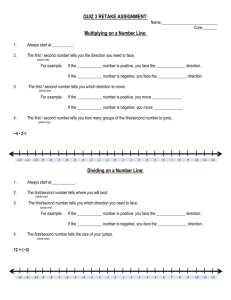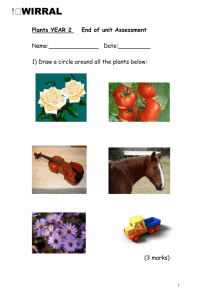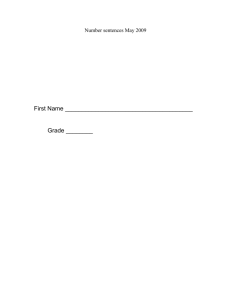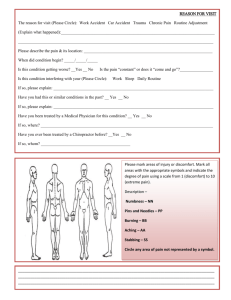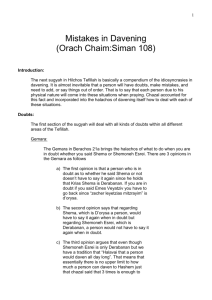Tefillah-Yoga.doc
advertisement
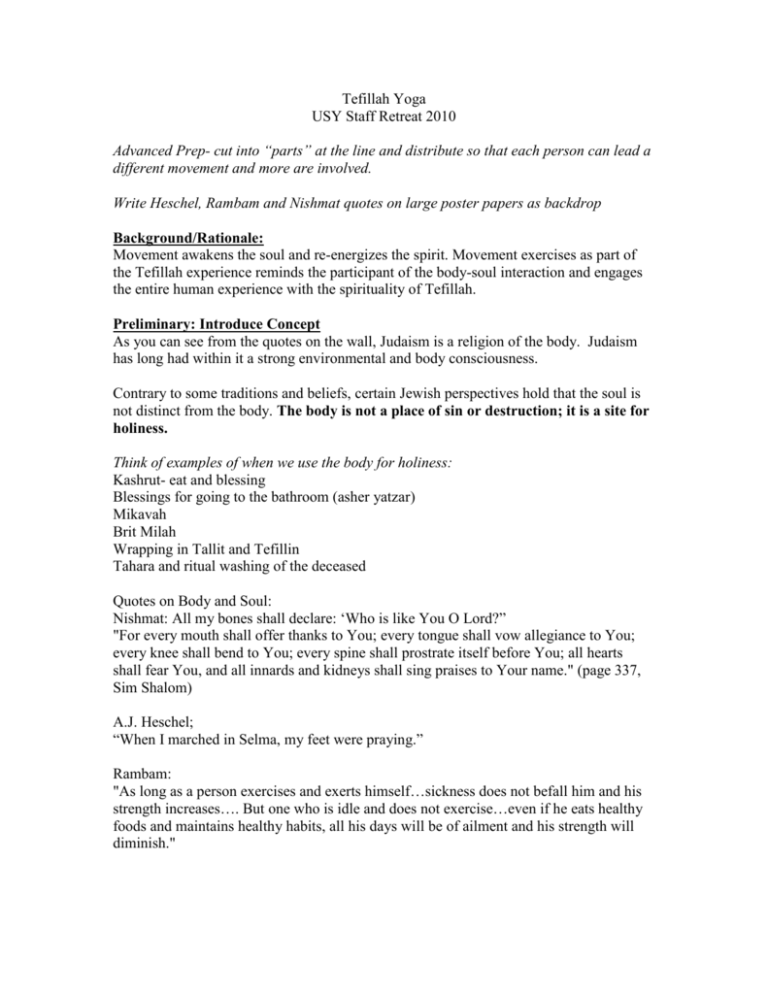
Tefillah Yoga USY Staff Retreat 2010 Advanced Prep- cut into “parts” at the line and distribute so that each person can lead a different movement and more are involved. Write Heschel, Rambam and Nishmat quotes on large poster papers as backdrop Background/Rationale: Movement awakens the soul and re-energizes the spirit. Movement exercises as part of the Tefillah experience reminds the participant of the body-soul interaction and engages the entire human experience with the spirituality of Tefillah. Preliminary: Introduce Concept As you can see from the quotes on the wall, Judaism is a religion of the body. Judaism has long had within it a strong environmental and body consciousness. Contrary to some traditions and beliefs, certain Jewish perspectives hold that the soul is not distinct from the body. The body is not a place of sin or destruction; it is a site for holiness. Think of examples of when we use the body for holiness: Kashrut- eat and blessing Blessings for going to the bathroom (asher yatzar) Mikavah Brit Milah Wrapping in Tallit and Tefillin Tahara and ritual washing of the deceased Quotes on Body and Soul: Nishmat: All my bones shall declare: ‘Who is like You O Lord?” "For every mouth shall offer thanks to You; every tongue shall vow allegiance to You; every knee shall bend to You; every spine shall prostrate itself before You; all hearts shall fear You, and all innards and kidneys shall sing praises to Your name." (page 337, Sim Shalom) A.J. Heschel; “When I marched in Selma, my feet were praying.” Rambam: "As long as a person exercises and exerts himself…sickness does not befall him and his strength increases…. But one who is idle and does not exercise…even if he eats healthy foods and maintains healthy habits, all his days will be of ailment and his strength will diminish." RUNNING THE PROGRAM Start with the preliminary explanation of Judaism and the body and have someone read aloud the sources on poster paper. Each Tefillah used in this service has an explanation and a movement. Read the explanation to connect the meaning of the Tefillah to the movement. indicates movement Warm Up Exercise- Tallit and Tefillin Talit and TefillinBEFORE you put on your Tallit and Tefillin, go through the movements 7 arm circles, representing wrapping our Tefillin . Roll head side to side to include the head as part of Tefillin. Put on Tefillin sweep arms in a circular motion around body as if wrapping Tallit. Now try it with Tallit. Say bracha -----------------------------------------------------------------------------------------------------------Shacharit *note- each explanation and action will preface the recitation of the Tefillah Modeh Ani: Restoration of my soul- page 2 Explanation- I am thankful that God has restored my soul and made me, me! Exercise: Option 1: She’hechezarta et nishmati: Go around the circle and have everyone come up with one movement that presents their neshama, who they are. Example- I give myself a hug because I try to be warm and welcoming to others Option 2: waking up from slumber Go through each body part in Hebrew from toe to head and move it slowly to awaken your body and soul for prayer Ideas: Circle the head, shrug shoulders, move your head side to side (say hello to person beside you!) Shake shoulders- k’tayfayim Circle elbows- marpek Bend torso down, lift up- torso in Hebrew is torso Circle hips- mot’nayim Squeeze hands into fists and release (yadayim b’egrofim) Round the back and arch it (gav) Circle the legs- raglayim Stand on tip toes (practice for K’dusha!)- etzba’ot Open feet apart, bring together- caf regel Mah Tovu- page 2 Explanation: The words of Mah Tovu are an expression of how peaceful and harmonious our communities are (Bilaam story of curse to blessing) and remind us of the sacredness of our prayer space Option 1: Have pairs of people spread extra Tallitot over a tight group of people to create a sacred space.Wrap arms around shoulders in circle to illustrate harmony (optional: sing Hiney Mah Tov) Option 2: have everyone form a “bridge” with a partner with arms overhead. Like the dance, Tayish, have everyone go through it singing the first line of Mah Tovu (up to Yisrael) ---------------------------------------------------------------------------------------------Birkot Hashchar- Page 10 Explanation- Birkot Hashachar guides through all of our movements of the morning routine from wake up, through getting dressed, eating breakfast, etc. We can translate these brachot into symbolic actions that present our morning routine. Baruch- bow Ata Adonai- rise on toes and stretch Eloheinu melech ha’ola- stretch arms out it front (for all of world) Stand in a circle and as you read each blessing, have different volunteers (you can go around the circle) read the English and come up with a movement that corresponds to the bracha. Have everyone mimic the action and recite the Hebrew. Following Psalm 30/Mizmor Shir Baruch She’amar- speaking with movement- sign language- page 54 Explanation: Baruch She’amar tells us that God created the world with words- God acted through God’s words as do we speak using our actions with sign language. Go through motions of each word and then try it all together. BARUCH- Thumbs up, hands in fists. Start near moth and move hands down and outward in a flowing motion. Our blessing spreads into the world. HU- right index finger points up, arm up SHEMO- His Name (we’re only going to do “name) Cross middle and index finger of left hand over those two fingers of the right hand to make an “X.” Tuck other fingers away. SHE’AMAR- “The One who spoke” Touch pointed index finger to lips, spiral out from lips with finger as words flowing from mouth V’- And- grasping motion of the right hand at chest level HAYA- “came into being”- hold both hands out in front of you, palms open. Circle hands in flowing outward motion as if unfolding creation OLAM- “world”- make a “W” with each hand, using your three fingers, tuck pinky and thumb in. Make a circle motion with your two hands as if planets rotating around each other Source: Karov L’chol Korav Following Baruch She’amar Ashrei (use interpretive translations on page 67 of Karov L’chol Korav)- page 80 Explanation- an acrostic of happiness, wonder and awe of God Movements for each verse (stylized, personalized movements) Stand in a circle and have each person, line by line, step forward into the circle, read the Hebrew line, then the interpretive line and come up with a movement that corresponds to the meaning of the interpretive translation. Then, pass the interpretive translation paper to the next person. Demonstrate example: Hebrew text: Ashrei yoshvei vetecha, od yehalelucha sela Interpretive Translation: People who feel close to God have great happiness Action- point to your huge smile! Following Hatzi Kadish: Barchu/Yotzer Or- Sun Salutation- page 96 Explanation- letting light in- Barchu highlights themes of creation and light but also we recite Barchu as a reminder to let light shine in our lives. Yoga move- Sun Salutation (12 moves but we’ll do just part of it) Stand erect with your arms above your head. Arch your back backwards and move arms behind you so you make a semi-circle with your body (if too difficult to do backwards, arch forwards). Following Barchu: Shema- page 100 Explanation- the Shema involves a number of different actions and movements. Before we say the Shema, we’re going to review the movements and actions found in the Shema: Shema Yisrael- We listen with our ears but in order to listen, we must cover our eyes to focus on our words- sweep hands over eyes V’haya lachem tzizit- Hands/fingers- Tzizit-pretend to gather tzitzit Lips- Kiss those tzizit! U’kshartem L’ot- bind them as a sign- Tefillin- circle hands as if binding tzizit, touch head ---------------------------------------------------------------------------------------------------------Following Mi Chamocha/Tzur Yisrael Amidah- page 106 Explanation: Moving the Body to the Brachot Before we read the Amidah, we prepare ourselves for prayer with our bodies. How can we include our bodies during the Tefillah so that we may connect with some of the brachot? *note: this is for learning purposes only. We will not add new choreography to the traditional movements. If it’s easier for you, read the Amidah in English. As you read the Amidah, choose one bracha that you connect with and think of a movement as expression of that bracha. Following the Amidah, we will demonstrate some of these movements (for those who choose to). Following Kadish Shalem Aleinu- page 160 Explanation- Aleinu reminds us of God’s Supreme Kingship and Creator of the universe. Standing in a circle, place your hands on the person’s shoulders in front of you and arch your back inward to create a globe of the world as a symbol of God’s creation -------------------------------------------------------------------Following Shir Shel Yon and Psalm for Days of Awe Adon Olam- page 6 Explanation- The last line of Adon Olam says: “Adonai li v’lo ira” “God is with me, I shall not fear. Body and Spirit in His keep” This is a powerful chatima or “seal” to our morning worship: “God is with me, I shall not fear”- strike a pose for what that means to you. Conclusion/For more info: Movement can engage the body with the spirit. It can not only keep everyone involved and awake but also used to help connect with and explain the meaning of the various Tefillot. Movement can also be used to teach Torah stories, Jewish values, mitzvot and ideas beyond just Tefillah. For more information on teaching Jewish Values, stories and ides through movement, see article by Ofra Backenroth “Enriching Instruction With Dance and Movement,” The Ulimate Jewish Teacher’s Handbook, pages 592-597.


